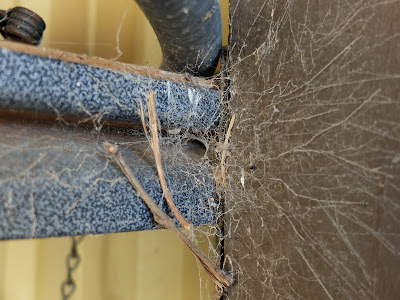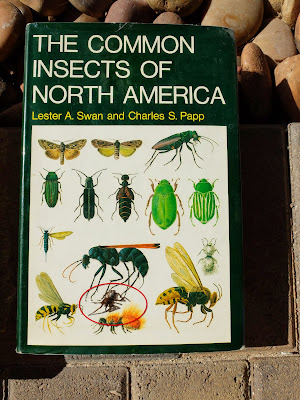Left: A Beautiful Web of the K. arizonica? Right: K. arizonica at night.

For years we knew this spider as only a “Phyllis Paddit” spider. It creates webs all over the Imperial Valley ranch where we stay. The webs are sticky and hard to remove. A type of flycatcher uses the webs to construct resilient nests. Despite all of this, I’d never seen one of these spiders. So I investigated.
The investigation trail went something like this:
- I happened to come across the web site Spiders of the Californias where I was contemplating the type of spider web I was seeing. Answer: funnel weaver.
- Okay, funnel weaver, but I needed more. So I started searching for spider web imagery, in particular, images of funnel weaver (family Agelenidae) webs. I happened to come across an image that looked very similar to the webs I was seeing. The caption of the photo was “Agelenidae or Filistata”.
- Suddenly it occurred to me that maybe there was an error in the transmission of the name, a classic case of Chinese whispers or the telephone game. The genus Filstata of spiders are called the filistatid. Sounds like Phyllis Paddit? Another case of funny naming is the “Swamp Molly” (see Swamp Mallet – Eucalyptus spathulata).
- The genus Kukulcania is another genus in the Filstatidae family – a family known as the crevice weavers. The genus is named for the Kukulcan, a Maya snake deity.
- Over time, I came to suspect the spider we call “Phyllis Paddit” is likely Kukulcania arizonica – the Arizona Black Hole Spider.
Some other interesting tidbits if this is indeed K. arizonica:
- These spiders are called cribellate spiders. In the Wikipedia entry for the related species, Kukulcania hibernalis (Southern house spider) there is this statement: “The southern house spider is a cribellate spider. That is, its spinnerets do not produce adhesive webbing. Instead, to capture prey the spider uses its legs to comb webbing across its cribellum, a spiked plate near the spinnerets. This combing action frays and tangles the strands, producing a fine, velcro-like netting that ensnares insect legs.”
- From the Wikipedia entry for Kukulcania arizonica: “This is a black spider with a velvety texture. It builds a silken tube in a crevice, often on the wall of a building, with silken threads radiating from the entrance. The female, around 13 mm in length (excluding legs), can live for several years.” Yup, radiating webs alright and about the right size.
- We only saw the spiders in the photos below at night. During the day, you would be hard-pressed to see them. Even at night, many of the specimens we approached retreated into their tunnels/crevices upon our approach.
There is more information about Kukulcania in the Field Guide to the Spiders of California and the Pacific Coast States.
As if to prove a point in terms of how much these spiders permeate the outdoors and indoors around here (Imperial Valley), we went to remove a book on insects from a shelf and out came a K. arizonica. Kulcania is not listed in the book, The Common Insects of North America, of course, because it isn’t an insect!
Kukulcania arizonica at night.









Kukulcania arizonica on an insect book – “Hey, I’m not an insect!”


These spider's are in northwest Arkansas also & they love to cime indoor's ahen the weather start's cooling down in late September. One large black female has made her home in one of my couches & has stayed all year, in early summer I started seeing spiderling's running around in my kitchen & laundry room
ReplyDeleteI Saw this webs in Canary Islands too
ReplyDelete